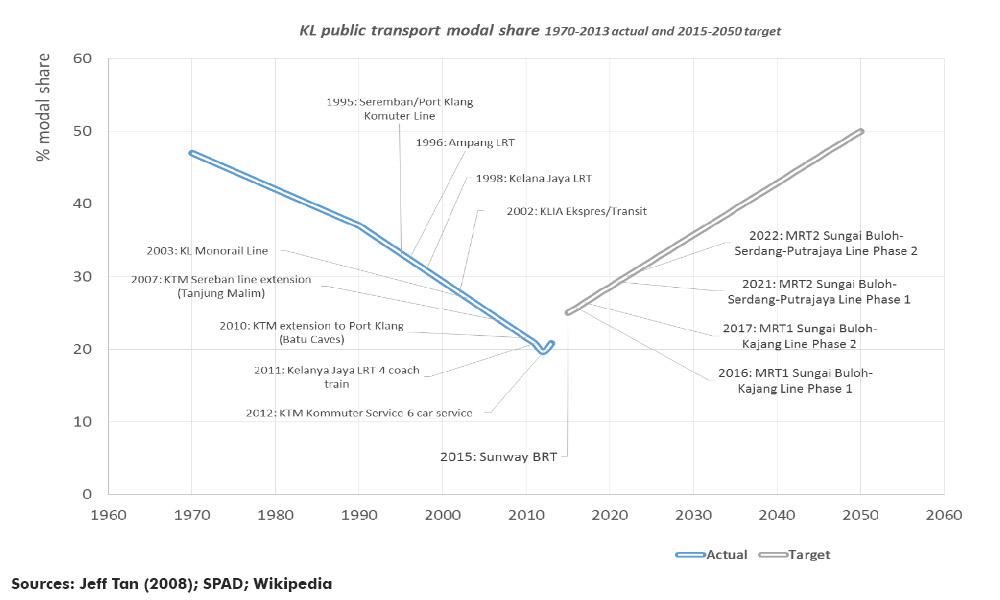Conventional belief is wrong. Conventional belief has it that widening roads will reduce traffic congestion. This is still the mindset our engineers and political leaders. But conventional wisdom is time and again proved factually wrong. In fact, the counter-intuitive is right, i.e., road widening creates more traffic congestion. While the counter-intuitive is not obvious, the factual evidence is staring us in our faces.
From Bangkok to Beijing, the endless spaghetti of super highways has only worsened traffic congestion. Beijing started with the first outer ring road to relieve city traffic congestion. Today it has eight such outer ring roads, and the traffic has gotten worse!
But the most recent evidence of the failure of road building and conversion to the new paradigm comes from Sylvester Turner, the new mayor of Houston, a car-centric city.
In April 2016, he admitted that the city spent US$2.6 billion (RM10 billion) to construct the world’s widest highway with 26 lanes and this only contributed to worsening traffic congestion. He then urged a new paradigm -move away from widening roads to public transportation solutions and encourage car sharing and high-occupancy vehicle (HOV) lanes.
Why road expansion results in worsening traffic congestion
The US has spent trillions of dollars trying to reduce congestion by road widening but this has actually CREATED new car trips that would not have occurred without road widening. Why? Because increasing the supply of roads only creates higher demand for its use.
Two things happen. First, like the mathematician, Braess, predicted decades ago, motorists who have taken alternative roads now converge on the widened road resulting in congestion. Second, people who would have used public or other modes of transport now opt to drive as it is more convenient. So we get back to square one; and we are worse off financially and environmentally.
Despite this overwhelming evidence, Penang, that prides itself as forward looking and leading, is actually caught in a time warp.
Moving cars not people - the Penang reality
Despite the Penang state government’s transportation slogan of moving people not cars, it is actually the doing the opposite. This is evident from the priority the transport plan gives to road building both in terms of timing and expenditure.
Under the Halcrow transport plan 61 percent of the RM27 billion is for road improvement and building. Under the first phase of the proposed SRS transport plan, 50 percent is for building roads. This is moving cars, not people.
The first phase of the SRS transport plan proposes to build the Pan Island Link (PIL1) and a LRT line from George Town to the SRS island B between 2017-2011. The PIL1 is estimated to cost RM6.1 billion and the LRT line RM6.2 billion for a total of RM12.3 billion.
Disastrous to promote car usage and public transport at same time
If the state is serious about increasing the public transport modal share from the present paltry 3 to 40 percent by 2030 (which is unrealistic under the SRS proposal), it should spend most, if not all, of the money to build public transport and not roads. It should simultaneously take proactive steps to discourage motorists from using private vehicles.
However, the present strategy of the Penang state to prioritise and provide far higher investments in highways only serves to encourage motorists to drive and use the highways particularly when they are free of charge. This will discourage public transportation use.
The SRS proposal is to spend RM6 billion to build the Pan Island Link (PIL 1) to the airport cutting north-south travel time to 15 minutes. And no tolls will be collected. This whole strategy is fundamentally flawed from the start. If it is cheaper and faster to use the PIL to get to the airport, people will shun the LRT for cars. This will lead to financial disaster as public ridership will be reduced.
For example, the actual ridership of the KL PUTRA LRT line reached only 3 percent of projected ridership in 1999 and 44 percent four years after starting operation.
The experience in the KL-Klang region clearly demonstrates the folly of such a failed strategy where despite the provision of two LRT lines and one monorail line public modal share of transport dropped from over 40 percent in 1970s to 17 percent in 2014 as shown in the chart below.

Financial failure of a non-balanced strategy
Furthermore, the bad financial experience of the two LRT companies (Smart and Putra) and the KL monorail should be an eye-opener for Penang. The two LRT companies faced financial difficulties within the first year of operation (circa 1998/99) due to poor ridership and were bailed out by the federal government. In the case of the KL Monorail, the government gave a RM 300 million soft loan.
Then in November 2001, the Finance Ministry issued RM5.5 billion of bonds to purchase the debts of the two LRT companies (Jeff Tan, 2008: 114).
For a public transport system to succeed, we need both the pull and the push factors. The pull factors are providing convenient, punctual, frequent, affordable, accessible and well-connected public transport system.
But this alone will not do. The government must have the political will to implement push factor policy measures to discourage the use of private vehicles, such as higher parking charges, restricting parking spaces, and road congestion charges. One without the other will not do.
Reference: Jeff Tan, 2008 Privatization in Malaysia (Routledge).
DR LIM MAH HUI is a member of the Penang Island City Council (MBPP).

